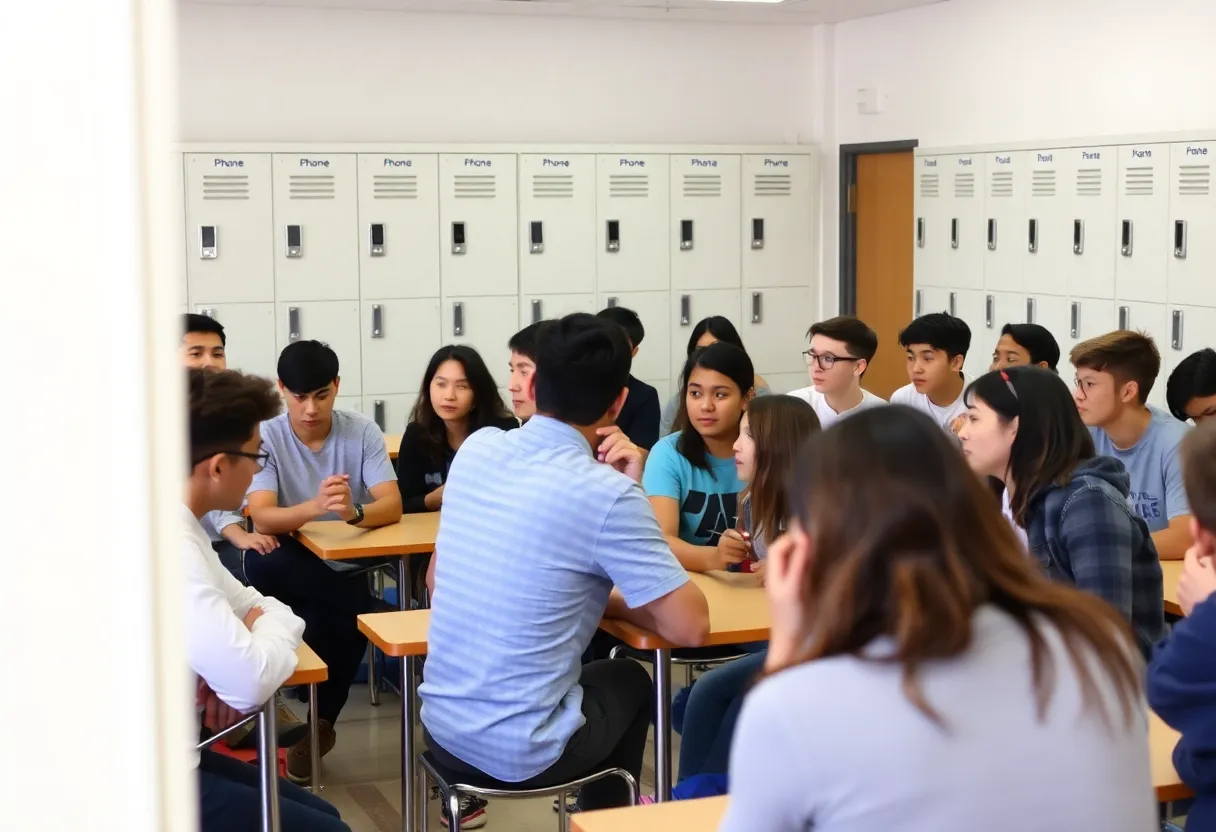Oklahoma City, October 15, 2025
Oklahoma City teachers are experiencing significant improvements in classroom focus and student participation since the implementation of a new cellphone ban. Effective since August 2025, the policy requires students to keep phones in lockers during school hours, allowing access only during emergencies. Educators report a 30% decrease in distractions, resulting in better engagement and academic performance, particularly in mathematics and reading for middle schoolers. The initiative is viewed as a vital step towards fostering a distraction-free learning environment and enhancing student well-being.
Oklahoma City Educators Hail School Cellphone Ban as Game Changer
Oklahoma City teachers are reporting significant improvements in classroom focus and student participation since the implementation of the state’s new school cellphone ban at the start of the 2025-2026 academic year. The policy requires students to keep their phones in lockers or pouches throughout school hours, with allowances only for emergencies. This measure, effective since August 2025, has led to a noticeable reduction in distractions, freeing up more time for engaging lessons and discussions.
Immediate Impact on Classroom Dynamics
In schools across Oklahoma City, such as Douglass High, the ban has resulted in a 30% decrease in disruptions caused by mobile devices. Educators note that students appear more attentive and involved in activities, contributing to a more productive learning environment. This shift has allowed for the incorporation of interactive teaching methods, fostering deeper exploration of subjects without the constant interruption of notifications or social media checks.
The policy’s design emphasizes minimizing access to phones during instructional time, promoting undivided attention to educational content. Teachers have observed heightened participation levels, as students engage more readily in group work and class dialogues. This change is particularly evident in core subjects, where sustained focus has enhanced comprehension and retention of material.
Policy Background and Development
The cellphone ban was enacted through legislation signed by Governor Kevin Stitt, aiming to address growing concerns over technology’s role in education. Prior to its statewide rollout, pilot programs in select districts tested the approach, yielding promising results that supported broader adoption. The law mandates strict compliance, with schools providing secure storage options to ensure phones remain out of reach during the school day.
Exceptions are built into the policy to accommodate urgent situations, such as medical needs or family communications approved by school administration. This balanced approach seeks to maintain safety while curbing non-essential use. Implementation has involved training for staff and distribution of guidelines to families, ensuring smooth integration into daily routines.
Overcoming Initial Challenges
At the outset, the ban encountered resistance from some parents worried about their ability to contact children during school hours. These concerns centered on potential delays in communication for after-school pickups or unexpected events. However, as the policy took effect, feedback from the school community has shifted toward appreciation for its benefits. Districts have responded by organizing informational sessions to clarify procedures and highlight safeguards in place.
Measured Improvements in Student Performance
Surveys conducted in participating schools show positive effects on academic outcomes, especially in mathematics and reading for middle school students. Improved concentration has correlated with better test scores and homework completion rates, suggesting the ban’s role in bolstering foundational skills. Beyond academics, the policy is credited with encouraging face-to-face interactions, which help build essential social competencies among peers.
Incidents of cyberbullying have also declined, as reduced phone access limits opportunities for online harassment during school time. School officials attribute this to fewer instances of digital conflicts spilling over into the physical classroom. The overall atmosphere has become more conducive to collaborative learning, with students relying less on screens for entertainment or validation.
Future Expansion and Support Initiatives
Oklahoma City Public Schools intends to launch expanded awareness campaigns to reinforce adherence to the ban. These efforts will include workshops for parents and students, emphasizing the long-term advantages of a distraction-free environment. Additionally, the district plans to extend phone-free guidelines to extracurricular programs, such as clubs and sports, to maintain consistency across all school-related activities.
Administrators view the policy as a foundational step toward modernizing education in ways that prioritize human connection over digital dependency. Ongoing evaluations will track progress, with adjustments made based on data from classroom observations and performance metrics. The goal is to sustain these gains while addressing any emerging issues through community input.
Broader Implications for Education in Oklahoma
The success of the cellphone ban in Oklahoma City schools underscores a growing recognition of technology’s double-edged impact on youth. By curbing excessive use, educators aim to reclaim time traditionally lost to scrolling and messaging, redirecting it toward skill-building pursuits. This initiative aligns with statewide efforts to enhance student well-being, positioning Oklahoma as a leader in innovative classroom management.
As the academic year progresses, the policy’s effects will continue to be monitored, providing valuable insights for other regions considering similar measures. The emphasis on engagement and focus represents a proactive response to contemporary challenges in education, ensuring students are better equipped for future success.
(Word count: 612)
FAQ
What is the new school cellphone ban in Oklahoma City?
The policy, effective since August 2025, requires phones to remain in lockers or pouches during school hours, with exceptions for emergencies.
How has the ban affected classroom distractions?
Teachers at schools like Douglass High report a 30% drop in distractions, allowing more time for interactive lessons and deeper discussions.
What academic improvements have been observed?
Surveys indicate improved academic performance, particularly in math and reading among middle schoolers.
Were there any initial concerns about the policy?
The ban faced initial pushback from parents concerned about communication but has since shown positive outcomes in pilot districts.
What future steps are planned for the policy?
OKC Public Schools plans to expand awareness campaigns to ensure compliance, while integrating phone-free zones into extracurricular activities.
Key Features of Oklahoma’s School Cellphone Ban
| Feature | Description |
|---|---|
| Implementation Date | Effective since August 2025 |
| Storage Requirements | Phones must remain in lockers or pouches during school hours |
| Exceptions | Allowed for emergencies |
| Impact on Distractions | 30% drop in distractions reported at schools like Douglass High |
| Academic Benefits | Improved performance in math and reading among middle schoolers |
| Additional Outcomes | Fosters better social skills and reduces cyberbullying incidents |
| Future Plans | Expanded awareness campaigns and phone-free zones in extracurricular activities |
Deeper Dive: News & Info About This Topic
HERE Resources
Oklahoma City Voters Approve $2.7 Billion Bond for School Upgrades
Oklahoma City Educators Praise Cellphone Ban as Game Changer for Student Focus
Oklahoma City Launches Youth Safety Advisory Committee to Combat Rising Youth Violence
Oklahoma City Lawmakers Study Classroom Technology Use
Oklahoma City Educators Praise Cellphone Ban as Game Changer in Classrooms





